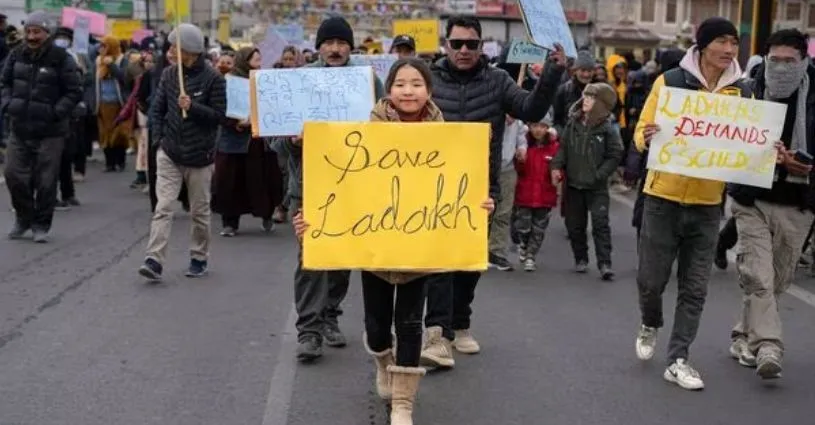Ladakh is currently witnessing significant protests, with thousands rallying for their political and social rights. The protests gained momentum rapidly in March 2024. Following the abrogation of Article 370, Jammu and Kashmir was formed into a union territory with a legislative assembly, while Ladakh became a Union Territory without a legislative assembly.
Why are they protesting?
People of Ladakh have been widely protesting since early 2024 demanding greater political autonomy and constitutional safeguards for their region, to conserve the environment and culture of the region. According to locals there is possibility of exploitation of the Ladakh’s fragile environment, as well as cultural and tribal demographic structure over there.
According to the activists, Ladakh is dealing with rapid ecological damage to it’s land and environment due to excessive industrialization and militarization.
To prevent this situation locals have staged these protests to lay their demands.
The VOA (Voice of America) and ABC (American Broadcasting Company) news outlets stated in their articles that the Ladakh protest has entered its third week as of 24th March, 2024.
What are their demands?
- Demand of statehood for Ladakh.
- Inclusion of Ladakh under sixth schedule of the Indian constitution, providing the region with morelegislative, judicial and administrative auntonomy.
- Creation of a seperate public service commission for Ladakh to ensure job opportunities for locals.
- Increase in the number of Lok Sabha representative seats from current 1 to 2 from Ladakh.
Who is leading?
On March 27, Sonam Wangchuk, a prominent figure in climate activism, an innovator and an educationist, led a large rally of thousands of protesters, towards the Line of Actual Control of China and India. The rally aimed to draw attention to pressing environmental concerns and urge the government to intervene and take action.
Sonam Wangchuk’s remarkable 21-day hunger strike, sustained solely on salt and water, concluded on March 26, 2024. His impassioned plea to the Prime Minister echoes the unfulfilled promises made to Ladakh’s people during the 2019 elections. Wangchuk’s unwavering dedication to advocating for the political and social rights of Ladakhis serves as a guiding of hope for the region’s future.
What are the Locals’ concerns?
According to representatives of protesters, including the Leh Apex Body (LAB) and theKargil Democratic Alliance (KDA), Ladakh, since its separation from the former state of Jammu and Kashmir in 2019, has experienced a loss of political representation at the national level. Locals express frustration that their concerns are not adequately heard. They reportedly fear that the Union territory status makes it easier for outsiders to purchase land, posing threats to the region’s cultural and ecological balance.
Ladakh is home to unique wildlife such as snow leopards, black cranes, and wolves. The prospect of large-scale industrialization, mining, and other development projects, without due consideration for Ladakh’s fragile ecosystem, is a major concern. Locals worry about the potential loss of land, pastures, habitats for communities, and wildlife. They are calling for sustainable development initiatives that prioritize local participation to safeguard the region’s future.
